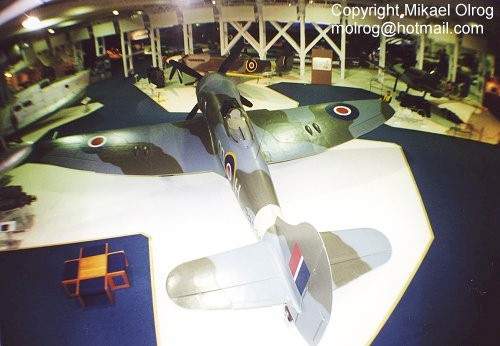| Hawker Tempest II PR-536 on display at RAF Hendon Museum was previously HA-457 with the Indian Air Force. the world. Pic Courtesy: Mikael Olrog – Axis Aircraft |
The Tempest currently on display at the Royal Air Force Museum at Hendon, just outside London in the UK, is actually a composite, built up out of components of three different aircraft. Two of the three, however, are known to have served with the Indian Air Force; and the RAF registration which is used as its identity, PR-536, is that of one of the Indian Air Force veterans.
PR-536 was built by Hawker Aircraft at Langley, and was one of a batch whose production was curtailed, probably due to the end of World War Two. It was shipped to 5 Squadron of the RAF, based at Peshawar (now in Pakistan), late in 1945. It is believed to have carried the RAF side letters ‘OQ-G’ and ‘OQ-H’ at this time.
5 Squadron, RAF, served for a period as the Tempest conversion unit for Indian squadrons that were converting to the Tempest. However, in common with other RAF Tempest squadrons based in India at the time, it disbanded and passed all its aircraft to one of several RIAF squadrons converting to the Tempest, some time between the end of 1946 and Independence in August 1947.
 |
This view of Hawker Tempest II PR-536 shows the pristine condition and display environment at the RAF Museum. Pic Courtesy: Mikael Olrog – Axis Aircraft |
By September 1947, PR-536 had acquired the Indian serial HA-457. It probably saw action in the Kashmir operations of 1947-48. It may have worn ACSEA camouflage initially; but for most of its time in RIAF (and from 26 January 1950 onwards, IAF) service, it would probably have flown in an overall metal finish, with black wing-tips and rudder, and rear fuselage bands. It would have appeared in the ‘Chakra’ markings that the Indian Air Force adopted briefly at this time; and later reverted to the more familiar IAF roundel-style markings.
Although details of HA-457’s IAF service are not known, together with other IAF Tempests, it would have been withdrawn from front-line service in 1953, and from service altogether by 1956.
After the Tempest was withdrawn from use by the IAF, between 1968 and 1979 several batches of substantially complete airframes, as well as spares packages and major components such as fuselages, wings and engines, were either gifted or sold by the Government of India to museums and to private collectors overseas. These disposals included, in particular, one pair of Tempest wings, known to be from Kanpur – although it is not known which aircraft they were originally from – which were presented to the RAF Museum in November 1971. They also include the fuselage and engine of HA-457, which were sold to Doug Arnold, a British private warbird collector, in 1977.
Between 1977 and 1987, the fuselage and engine combination of HA-457 changed hands twice more. Doug Arnold sold it on to Nick Grace, another UK-based private collector. Nick Grace in turn negotiated a deal to exchange it with the RAF Museum, in return for the fuselage and engine of a Tempest V variant.
In the period between 1987 and 1991, the front fuselage of HA-457 was mated with the pair of wings from Kanpur mentioned earlier, and with the rear fuselage of a ground instructional Tempest airframe acquired from the Royal Navy Engineering College at Manadon. The composite aircraft was then restored to static display condition. Most of the work on this restoration was carried out by The Fighter Collection, a British private warbird operating company, which did the work for the RAF Museum in exchange for ownership of one of the Tempest’s stablemates, a Hawker Sea Fury.
HA-457, now once again carrying its old RAF serial PR-536, has been on static display at the RAF Museum at Hendon since November 1991. It has been finished once again in the colours of 5 Squadron of the RAF, and once again wears the fuselage letters ‘OQ-H’, which it is believed represent its original identity. Apart from the example at the Indian Air Force’s own museum in Delhi, this is the only former Indian Tempest currently on public display. In its 5 Squadron RAF markings, it does not display an explicit token of its India connection (as some other Indian warbirds overseas do). But for those who know, 5 Squadron’s role as the conversion unit for Indian Tempest squadrons qualifies, as a strong token of connection with, and memory of, the Hawker Tempest’s intensive service in India.
Contents of this page are copyright © K Sree Kumar


